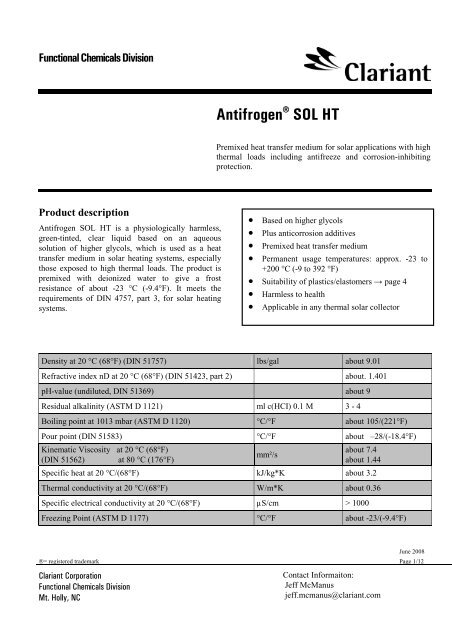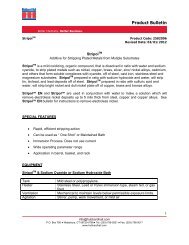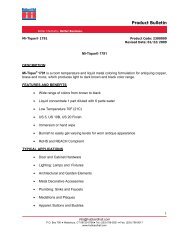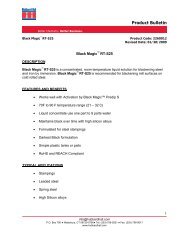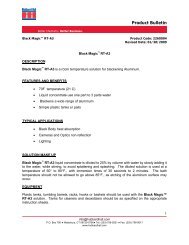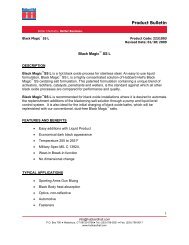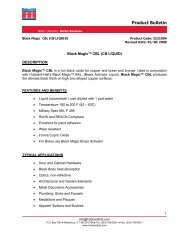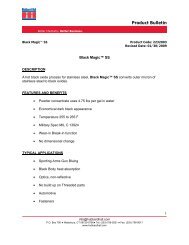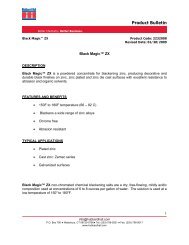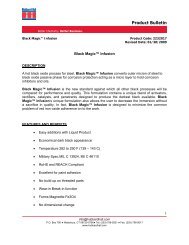Antifrogen SOL HT - Hubbard-Hall
Antifrogen SOL HT - Hubbard-Hall
Antifrogen SOL HT - Hubbard-Hall
You also want an ePaper? Increase the reach of your titles
YUMPU automatically turns print PDFs into web optimized ePapers that Google loves.
Functional Chemicals Division<br />
Product description<br />
<strong>Antifrogen</strong> <strong>SOL</strong> <strong>HT</strong> is a physiologically harmless,<br />
green-tinted, clear liquid based on an aqueous<br />
solution of higher glycols, which is used as a heat<br />
transfer medium in solar heating systems, especially<br />
those exposed to high thermal loads. The product is<br />
premixed with deionized water to give a frost<br />
resistance of about -23 °C (-9.4°F). It meets the<br />
requirements of DIN 4757, part 3, for solar heating<br />
systems.<br />
June 2008<br />
®= registered trademark Page 1/12<br />
Clariant Corporation<br />
Functional Chemicals Division<br />
Mt. Holly, NC<br />
<strong>Antifrogen</strong> ® <strong>SOL</strong> <strong>HT</strong><br />
Premixed heat transfer medium for solar applications with high<br />
thermal loads including antifreeze and corrosion-inhibiting<br />
protection.<br />
Density at 20 °C (68°F) (DIN 51757) lbs/gal about 9.01<br />
Refractive index nD at 20 °C (68°F) (DIN 51423, part 2) about. 1.401<br />
pH-value (undiluted, DIN 51369) about 9<br />
Residual alkalinity (ASTM D 1121) ml c(HCI) 0.1 M 3 - 4<br />
Boiling point at 1013 mbar (ASTM D 1120) °C/°F about 105/(221°F)<br />
Pour point (DIN 51583) °C/°F about –28/(-18.4°F)<br />
Kinematic Viscosity at 20 °C (68°F)<br />
(DIN 51562) at 80 °C (176°F)<br />
• Based on higher glycols<br />
• Plus anticorrosion additives<br />
• Premixed heat transfer medium<br />
• Permanent usage temperatures: approx. -23 to<br />
+200 °C (-9 to 392 °F)<br />
• Suitability of plastics/elastomers → page 4<br />
• Harmless to health<br />
• Applicable in any thermal solar collector<br />
mm²/s<br />
about 7.4<br />
about 1.44<br />
Specific heat at 20 °C/(68°F) kJ/kg*K about 3.2<br />
Thermal conductivity at 20 °C/(68°F) W/m*K about 0.36<br />
Specific electrical conductivity at 20 °C/(68°F) µS/cm > 1000<br />
Freezing Point (ASTM D 1177) °C/°F about -23/(-9.4°F)<br />
Contact Informaiton:<br />
Jeff McManus<br />
jeff.mcmanus@clariant.com
Functional Chemicals Division<br />
Notes on use<br />
Product properties<br />
The technical data below is used to describe the<br />
product and is taken from our own measurements or<br />
from literature. It does not constitute part of the<br />
delivery specification. The mandatory product<br />
specification will be found in the current technical<br />
data sheet.<br />
The certified quality system in accordance with DIN<br />
EN ISO 9001 is used in production and quality<br />
control. This ensures consistently high product<br />
quality.<br />
Application properties<br />
<strong>Antifrogen</strong> <strong>SOL</strong> <strong>HT</strong> was developed especially for use<br />
as a heat transfer medium in solar systems. The<br />
product is physiologically harmless.<br />
Phase separation of <strong>Antifrogen</strong> <strong>SOL</strong> <strong>HT</strong>/water<br />
mixtures does not occur.<br />
Frost resistance of the mixture does not change even<br />
after many years’ use, provided the <strong>Antifrogen</strong> <strong>SOL</strong><br />
<strong>HT</strong> concentration remains constant.<br />
Since <strong>Antifrogen</strong> <strong>SOL</strong> <strong>HT</strong> has a higher viscosity and<br />
density than pure water, a higher pressure drop must<br />
be expected in pipelines etc; graphs of the relative<br />
heat transfer coefficient and relative pressure drop –<br />
in comparison with pure water – are particularly<br />
useful for calculation purposes. These graphs and<br />
other physical data can be found in the appendix.<br />
<strong>Antifrogen</strong> <strong>SOL</strong> <strong>HT</strong> contains corrosion inhibitors that<br />
protect the metals of the solar systems, even in<br />
combined systems, permanently against corrosion and<br />
prevent the formation of boiler scale.<br />
The effectiveness of the inhibitor combinations is<br />
checked constantly by the manufacturer by means of<br />
the well-known corrosion test method ASTM D 1384<br />
(American Society for Testing and Materials).<br />
<strong>Antifrogen</strong> ® <strong>SOL</strong> <strong>HT</strong><br />
June 2008<br />
®= registered trademark Page 2/12<br />
Clariant Corporation<br />
Functional Chemicals Division<br />
Mt. Holly, NC<br />
Glycol/water mixtures without inhibitors cannot<br />
be used because they are more corrosive than pure<br />
water alone.<br />
The following table shows the relatively low<br />
corrosion of common metals caused by an <strong>Antifrogen</strong><br />
<strong>SOL</strong> <strong>HT</strong> compared with water and cooling brine.<br />
The values, determined by the above mentioned<br />
ASTM method, show the weight loss of metals in<br />
g/m² due to corrosion:<br />
Corrosion of metals in g/m², tested in accordance<br />
with ASTM D 1384 (336 h/88 °C/(190.4°F), 6 l<br />
air/h)<br />
Copper<br />
Soft solder<br />
(WL 30)<br />
Brass<br />
(MS 63)<br />
Steel<br />
(CK 22)<br />
Cast Iron<br />
(GG 25)<br />
Cast Aluminium<br />
(AlSi6Cu3)<br />
Stainless steel<br />
(1.4541)<br />
<strong>Antifrogen</strong> <strong>SOL</strong><br />
<strong>HT</strong> a<br />
Higher Glycols b<br />
Contact Information:<br />
Jeff McManus<br />
jeff.mcmanus@clariant.com<br />
Propylene glycol c<br />
Tap water d<br />
-2.3 -15.3 -2.8 -1<br />
-3.7 -68.2 -136 -11<br />
-1.0 -64.4 -2.5 -1.0<br />
< 0.1 -148.5 -225 -76<br />
-0.4 -73.5 -92 -192<br />
-1.5 -6.7<br />
< -0.1 Not<br />
tested<br />
-68 -32<br />
Not<br />
tested<br />
-0.5<br />
a <strong>Antifrogen</strong> <strong>SOL</strong> <strong>HT</strong> (undiluted); b Higher glycols 1:1 water mixture<br />
without inhibitors; c Propylene glycol 1:2 water mixture without<br />
inhibitors, d Tap water (14° dH);
Functional Chemicals Division<br />
It is advisable, if at all possible, not to use the<br />
product in galvanized pipelines, since all<br />
glycol/water mixtures can dissolve zinc.<br />
The good corrosion-inhibiting properties of<br />
<strong>Antifrogen</strong> <strong>SOL</strong> <strong>HT</strong> decrease as expected with<br />
increasing water content. The water used to dilute<br />
<strong>Antifrogen</strong> N shall contain no more than 100 mg/kg<br />
(ppm) chlorides. A wide range of water hardness is<br />
acceptable (between 0 and 180 ppm). This means,<br />
that in addition to fully deionized water, ordinary<br />
tap water may be used.<br />
The frost resistance of <strong>Antifrogen</strong> <strong>SOL</strong> <strong>HT</strong> is<br />
adjusted to a pour point of -28 °C/(-18.4°F) (freezing<br />
point: -23 °C/(-9.4°F)). Trials have shown that under<br />
North American winter conditions this formulation<br />
will not cause bursts in metal system components<br />
because slush ice is formed when the product is<br />
cooled below the crystallization point. The frost<br />
resistance is of course reduced by mixing with water,<br />
as the curves in the appendix indicate.<br />
Special antifreeze testers are available for<br />
determining frost resistance.<br />
<strong>Antifrogen</strong> <strong>SOL</strong> <strong>HT</strong> is premixed with deionized water<br />
and formulated to give the optimum frost and<br />
corrosion resistance. If traces of water still remain in<br />
the system after flushing or the user inadvertently<br />
dilutes the product, additions of water up to 10% can<br />
be tolerated without any adverse effect on corrosion<br />
resistance.<br />
Heat resistance<br />
<strong>Antifrogen</strong> <strong>SOL</strong> <strong>HT</strong> was developed because of the<br />
increased use of vacuum collectors, which have a<br />
high stagnation temperature of over +260<br />
°C/(+500°F). Typical ethylene and propylene glycol<br />
based heat transfer media tends to evaporate in such<br />
systems at high temperatures due to the low boiling<br />
point of these glycols. They leave partially insoluble,<br />
salt-like residues that can lead to operating problems<br />
if the collector is frequently idle and can result in<br />
failure of the system. <strong>Antifrogen</strong> <strong>SOL</strong> <strong>HT</strong> consists<br />
<strong>Antifrogen</strong> ® <strong>SOL</strong> <strong>HT</strong><br />
June 2008<br />
®= registered trademark Page 3/12<br />
Clariant Corporation<br />
Functional Chemicals Division<br />
Mt. Holly, NC<br />
predominantly of higher-boiling, physiologically<br />
harmless, higher-molecular-weight glycols with a<br />
boiling point of over +270 °C/(+518°F)at 1013 mbar.<br />
Use of <strong>Antifrogen</strong> <strong>SOL</strong> <strong>HT</strong> ensures that the abovementioned<br />
residues remain liquid.<br />
Nevertheless, operating temperatures of more than<br />
+200 °C/(+392°F) should be avoided. At higher<br />
temperatures not only can the chemical basis of the<br />
heat transfer medium decompose, causing the liquid<br />
to darken, but some corrosion inhibitors can also be<br />
inactivated. Sporadic high temperature loads can<br />
cause a decoloration of the fluid, but decoloration<br />
alone has no effect on the properties of the product.<br />
Circulating pumps should be selected with special<br />
regard to their suitability for operation with antifreeze<br />
agents. Pump components made, for example, of<br />
materials based on phenolic resins do not meet this<br />
requirement. However, the circulating pumps<br />
normally used in heating installations have been<br />
found to be resistant.<br />
According to data published in the literature and the<br />
results of our own tests and trials, the following<br />
plastics and elastomers are suitable for the<br />
manufacture of components coming into contact with<br />
<strong>Antifrogen</strong> <strong>SOL</strong> <strong>HT</strong>. The maximum temperatures<br />
specified by the manufacturer should not be<br />
exceeded.<br />
Contact Information:<br />
Jeff McManus<br />
jeff.mcmanus@clariant.com
Functional Chemicals Division<br />
Butyl rubber (IIR)<br />
Fluorcarbon elastomers, e.g. (FPM)<br />
®Viton (Du Pont)<br />
Natural rubber up to 80 °C (NR)<br />
Nitrile rubber, e.g.<br />
®Perbunan (Bayer)<br />
Olefin rubber, e.g. ®Buna AP<br />
(Bayer)<br />
<strong>Antifrogen</strong> ® <strong>SOL</strong> <strong>HT</strong><br />
June 2008<br />
®= registered trademark Page 4/12<br />
Clariant Corporation<br />
Functional Chemicals Division<br />
Mt. Holly, NC<br />
(NBR)<br />
(EPDM)<br />
Polychlorbutadiene<br />
(CR)<br />
elastomers, e.g. ® Neopren<br />
Silicon rubber, e.g. ®Elastosil (Si)<br />
(Wacker)<br />
Styrene butadiene rubber up (SBR)<br />
to 100 °C<br />
Polyacetal, e.g. ®Hostaform (POM)<br />
(Ticona)<br />
Polybutene, e.g. ®Rhiatherm (PB)<br />
(Simona)<br />
Polyester resins (UP)<br />
Polypropylene, e.g.<br />
®Hostalen PPH 2222<br />
(PP)<br />
Polyvinylidenedifluorid (PVDF)<br />
Polytetrafluoroethylene, e.g.<br />
®Hostaflon<br />
flex. Polyolefine<br />
e.g. ®Bauder Thermoplan T-<br />
SV (for flat roofs)<br />
(PTFE)<br />
(FPO)<br />
Phenol-formaldehyde resins, plasticized PVC and<br />
polyurethane elastomers are not resistant.<br />
Experience has shown that the well-known IT<br />
(rubber-asbestos) seals, as well as EPDM elastomer<br />
seals are suitable for these systems.<br />
For threaded pipe connections, in which hemp is used<br />
as a seal, coating with Fermit or Fermitol (Nissen und<br />
Volk) or Loctite 511 (Loctite Corp.) has proved<br />
successful.<br />
Tests have shown that the materials used for pressure<br />
surge compensators e.g. ® Flexon (Flamco) are not<br />
affected by <strong>Antifrogen</strong> <strong>SOL</strong> <strong>HT</strong>.<br />
Notes for use in solar heating systems<br />
<strong>Antifrogen</strong> <strong>SOL</strong> <strong>HT</strong> is an ideal heat transfer medium<br />
for highly stressed solar heating systems, particularly<br />
those with vacuum collectors. The materials normally<br />
used in solar heating systems, such as copper,<br />
stainless steel and aluminum, are protected from<br />
corrosive attack for many years by special corrosion<br />
inhibitors. To ensure optimum protection, the<br />
following advice should be followed:<br />
1. The system should conform with the<br />
requirements of DIN 4757 and must be designed<br />
as closed circuits. The membrane pressure surge<br />
compensators must conform with DIN 4807.<br />
2. Before filling, the system should be flushed out<br />
with water. Pipe joints, valves and circulating<br />
pumps should be pressure-tested for leaks.<br />
3. Hard-soldered joints are preferable to softsoldered.<br />
Traces of flux (if possible chloride-<br />
free) must be removed by pumping through with<br />
hot water.<br />
4. If at all possible, galvanized components should<br />
not be used in the system. Zinc is not resistant to<br />
the <strong>Antifrogen</strong> <strong>SOL</strong> <strong>HT</strong> and tends to start<br />
dissolving, which can lead to formation of<br />
sludge. Dirt traps and filters can help here.<br />
5. After pressure testing, the system should be<br />
drained and then filled immediately with<br />
<strong>Antifrogen</strong> <strong>SOL</strong> <strong>HT</strong> to eliminate any air pockets.<br />
This process also affords an opportunity to<br />
determine the capacity of the system from the<br />
amount of water used (water meter).XXXX<br />
XXXX XX XXXXXXXXxxxxxxxxxxxxXXXX<br />
XXXXXXXXX<br />
Contact Information:<br />
Jeff McManus<br />
jeff.mcmanus@clariant.com
Functional Chemicals Division<br />
6. Long-term no-load operation of the system<br />
should be avoided because this can adversely<br />
affect the stability of the heat transfer medium<br />
and considerably reduce its service life.<br />
7. In the event of leaks, always top off with<br />
undiluted <strong>Antifrogen</strong> <strong>SOL</strong> <strong>HT</strong>. Avoid mixing it<br />
with other products. If, in exceptional cases,<br />
water is used to top off the system, the<br />
concentration (= frost resistance) of the heat<br />
transfer medium should be checked with a<br />
hydrometer. The frost resistance should be at<br />
least –20°C/(-4°F) to ensure adequate frost and<br />
corrosion resistance.<br />
Service and monitoring<br />
It has been found that <strong>Antifrogen</strong> <strong>SOL</strong> <strong>HT</strong> can be<br />
used in installations for many years. However, the<br />
<strong>Antifrogen</strong> <strong>SOL</strong> <strong>HT</strong> concentration (= frost resistance)<br />
should be checked annually. As required, the<br />
performance of the heat transfer medium and level of<br />
corrosion inhibition can also be checked by Clariant.<br />
If a 250 ml sample is provided, this service can be<br />
undertaken by Clariant Corporation, 625 East<br />
Catawba Ave, Mt. Holly, North Carolina, 28120.<br />
The data in our service report relate solely to the<br />
sample sent to us. Guidance on further use of the<br />
product tested assumes that the system is in proper<br />
condition and properly operated. We would expressly<br />
point out that, particularly where corrosion or scale is<br />
already present in the system, interactions with the<br />
product may occur with unpredictable consequences.<br />
We accept no liability whatsoever for any damage<br />
resulting from the improper condition or operation of<br />
the system.<br />
<strong>Antifrogen</strong> ® <strong>SOL</strong> <strong>HT</strong><br />
Safety, Toxicology and Ecology<br />
June 2008<br />
®= registered trademark Page 5/12<br />
Clariant Corporation<br />
Functional Chemicals Division<br />
Mt. Holly, NC<br />
<strong>Antifrogen</strong> <strong>SOL</strong> <strong>HT</strong> has neither a flash point nor an<br />
ignition point. The product is based on non-toxic<br />
glycols (higher polyalkylene glycols). The corrosion<br />
inhibitor formulation is phosphate and nitrite-free and<br />
consists essentially of physiologically harmless<br />
additives.<br />
Flash point<br />
(DIN 51758)<br />
Ignition temperatur<br />
(DIN 51794)<br />
Temperature class<br />
(DIN/VDE 0165)<br />
°C<br />
°F<br />
°C<br />
°F<br />
Contact Information:<br />
Jeff McManus<br />
jeff.mcmanus@clariant.com<br />
> 105 (not detectable)<br />
> 221<br />
> 420<br />
> 788<br />
T2<br />
More information can be found in the material<br />
safety data sheet (MSDS).<br />
The results of ecotoxicological studies confirm the<br />
good biodegradability and toxicological inertness of<br />
<strong>Antifrogen</strong> <strong>SOL</strong> <strong>HT</strong>. In concentrations up to 1000<br />
mg/l, <strong>Antifrogen</strong> <strong>SOL</strong> <strong>HT</strong> shows no acute harmful<br />
effects on fish and bacteria. <strong>Antifrogen</strong> <strong>SOL</strong> <strong>HT</strong> is<br />
readily biodegradable.<br />
Spent <strong>Antifrogen</strong> <strong>SOL</strong> <strong>HT</strong> can be disposed of in a<br />
special waste incineration unit in accordance with<br />
local regulations. Further notes are contained in the<br />
latest material safety data sheet.
Functional Chemicals Division<br />
Transport and storage<br />
VbF (German regulations<br />
on flammable liquids)<br />
-<br />
GGVE/RID non-regulated<br />
GGVS/ADR non-regulated<br />
ADNR non-regulated<br />
IMDG-Code non-regulated<br />
DOT non-regluated<br />
IATA-DGR non-regulated<br />
<strong>Antifrogen</strong> <strong>SOL</strong> <strong>HT</strong> is supplied in road tankers, totes<br />
and drums. Since zinc is not resistant to <strong>Antifrogen</strong><br />
<strong>SOL</strong> <strong>HT</strong>, galvanized transport and storage containers<br />
should not be used. The product has a storage<br />
stability of two years.<br />
This information is based on our present state of<br />
knowledge and is intended to provide general notes<br />
on our products and their uses. It should not therefore<br />
be construed as guaranteeing specific properties of<br />
the products described or their suitability for a<br />
particular application. Any existing industrial<br />
property rights must be observed. The quality of our<br />
products is guaranteed under our General Conditions<br />
of Sale. We would like to specifically point out that<br />
any corrosion or deposits already present in the<br />
system may interact with the product with<br />
unpredictable consequences. We accept no liability<br />
for any damage due to the system being maintained in<br />
an improper condition or operated incorrectly.<br />
<strong>Antifrogen</strong> ® <strong>SOL</strong> <strong>HT</strong><br />
June 2008<br />
®= registered trademark Page 6/12<br />
Clariant Corporation<br />
Functional Chemicals Division<br />
Mt. Holly, NC<br />
Appendix<br />
The following graphs provide information on the<br />
most important physical properties of <strong>Antifrogen</strong><br />
<strong>SOL</strong> <strong>HT</strong>.<br />
Due to calculations and the graphical illustration of<br />
the figures with an IT program, small variances of the<br />
physical data can occur.<br />
Clariant Corporation<br />
Functional Fluids Division<br />
Mt. Holly, North Carolina<br />
Tel. +1 704-822-2649, Fax +1 704-822-2193<br />
Clariant Vertrieb (Deutschland) GmbH & Co KG<br />
Division Functional Chemicals, Am Unisys Park 1<br />
D-65840 Sulzbach<br />
Tel. +49 6196/757-60, Fax: +49 6196/757-88 56<br />
Clariant Produkte (Deutschland) GmbH<br />
Werk Gendorf, Division Functional Chemicals<br />
Functional Fluids/R&D<br />
D-84504 Burgkirchen<br />
Tel. +49 8679/7-22 72, Fax: +49 8679/7-50 85<br />
Internet:<br />
http://www.clariant.com<br />
Contact Information:<br />
Jeff McManus<br />
jeff.mcmanus@clariant.com
Functional Chemicals Division<br />
Kinematic Viscosity [mm²/s]<br />
1000<br />
100<br />
10<br />
<strong>Antifrogen</strong> ® <strong>SOL</strong> <strong>HT</strong><br />
June 2008<br />
®= registered trademark Page 7/12<br />
Clariant Corporation<br />
Functional Chemicals Division<br />
Mt. Holly, NC<br />
1<br />
Kinematic Viscosity<br />
of <strong>Antifrogen</strong> <strong>SOL</strong> <strong>HT</strong><br />
0<br />
-30 -20 -10 0 10 20 30 40 50 60 70 80 90 100<br />
Temperature [°C]<br />
Contact Information:<br />
Jeff McManus<br />
jeff.mcmanus@clariant.com<br />
100 Vol.-%<br />
=<strong>Antifrogen</strong><br />
<strong>SOL</strong> <strong>HT</strong>
Functional Chemicals Division<br />
Density [g/cm³]<br />
<strong>Antifrogen</strong> ® <strong>SOL</strong> <strong>HT</strong><br />
June 2008<br />
®= registered trademark Page 8/12<br />
Clariant Corporation<br />
Functional Chemicals Division<br />
Mt. Holly, NC<br />
Density<br />
of <strong>Antifrogen</strong> <strong>SOL</strong> <strong>HT</strong><br />
1.10<br />
1.09<br />
1.08<br />
1.07<br />
1.06<br />
1.05<br />
1.04<br />
1.03<br />
10/50 20/68 30/86 40/104<br />
50/122<br />
Temperature [°C/°F]<br />
60/140 70/158 80/176<br />
Contact Information:<br />
Jeff McManus<br />
jeff.mcmanus@clariant.com<br />
100 Vol.-%<br />
= Antifroge<br />
SO L
Functional Chemicals Division<br />
Density [g/cm³]<br />
Spec. Heat [kJ/kgK]<br />
1.08<br />
1.08<br />
1.07<br />
1.07<br />
1.06<br />
1.06<br />
3.40<br />
3.35<br />
3.30<br />
3.25<br />
3.20<br />
3.15<br />
3.10<br />
<strong>Antifrogen</strong> ® <strong>SOL</strong> <strong>HT</strong><br />
June 2008<br />
®= registered trademark Page 9/12<br />
Clariant Corporation<br />
Functional Chemicals Division<br />
Mt. Holly, NC<br />
Density<br />
of <strong>Antifrogen</strong> <strong>SOL</strong> <strong>HT</strong> - water mixtures<br />
7 8 8 9 9 10<br />
<strong>Antifrogen</strong> <strong>SOL</strong> <strong>HT</strong> [Vol.-%]<br />
Specific Heat<br />
of <strong>Antifrogen</strong> <strong>SOL</strong> <strong>HT</strong><br />
40/104 50/122 60/140 70/158 80/176<br />
Temperature [°C/°F]<br />
Contact Information:<br />
Jeff McManus<br />
jeff.mcmanus@clariant.com<br />
100 Vol.-%<br />
=<strong>Antifrogen</strong> <strong>SOL</strong> <strong>HT</strong>
Functional Chemicals Division<br />
Thermal Conductivity [W/mK]<br />
0.40<br />
0.38<br />
0.35<br />
0.33<br />
0.30<br />
<strong>Antifrogen</strong> ® <strong>SOL</strong> <strong>HT</strong><br />
Comment on Thermal Conductivity: Thermal conductivity has been analyzed by two independent external institutions. Multiple evaluations have<br />
revealed a slightly increased spread of the data points, especially at low temperatures. In the graph the averaged values are illustrated.<br />
June 2008<br />
®= registered trademark Page 10/12<br />
Clariant Corporation<br />
Functional Chemicals Division<br />
Mt. Holly, NC<br />
Thermal Conductivity<br />
of <strong>Antifrogen</strong> <strong>SOL</strong> <strong>HT</strong><br />
-20/-4 0/32 20/68 40/104 60/140 80/176 100/212<br />
Temperature [°C/°F]<br />
Vapor Pressure<br />
of <strong>Antifrogen</strong> <strong>SOL</strong> <strong>HT</strong><br />
40/104 60/140 80/176 100/212<br />
Temperature [°C/°F]<br />
0.<br />
0.<br />
0.<br />
0.<br />
0.<br />
0.<br />
0.<br />
0.<br />
0.<br />
Contact Information:<br />
Jeff McManus<br />
jeff.mcmanus@clariant.com<br />
Pressure [bar]
Functional Chemicals Division<br />
<strong>Antifrogen</strong> ® <strong>SOL</strong> <strong>HT</strong><br />
June 2008<br />
®= registered trademark Page 11/12<br />
Clariant Corporation<br />
Functional Chemicals Division<br />
Mt. Holly, NC<br />
Coefficient of Cubic Expansion<br />
of <strong>Antifrogen</strong> <strong>SOL</strong> VP 1981<br />
Coefficient of Cubic Expansion b [K -1 ]<br />
0.0009<br />
0.0008<br />
0.0007<br />
0.0006<br />
0.0005<br />
� = frost resistance<br />
0.0004<br />
-40/-40 -20/-4 0/32 20/68 40/104 60/140<br />
Temperature [°C/°F]<br />
80/176 100/212<br />
Contact Information:<br />
Jeff McManus<br />
jeff.mcmanus@clariant.com<br />
100 Vol.-%<br />
=<strong>Antifrogen</strong> <strong>SOL</strong>
Functional Chemicals Division<br />
Refractive Index [nD20]<br />
1.4<br />
1.4<br />
1.3<br />
1.3<br />
Frost Resistance [°C]<br />
-10<br />
-15<br />
-20<br />
-25<br />
-30<br />
Refractive Index<br />
of <strong>Antifrogen</strong> <strong>SOL</strong> <strong>HT</strong><br />
<strong>Antifrogen</strong> ® <strong>SOL</strong> <strong>HT</strong><br />
7 8 8 9 9 10<br />
<strong>Antifrogen</strong> <strong>SOL</strong> <strong>HT</strong> [Vol.-%]<br />
June 2008<br />
®= registered trademark Page 12/12<br />
Clariant Corporation<br />
Functional Chemicals Division<br />
Mt. Holly, NC<br />
Frost Resistance<br />
of <strong>Antifrogen</strong> <strong>SOL</strong> <strong>HT</strong><br />
75 80 85 90 95 100<br />
<strong>Antifrogen</strong> <strong>SOL</strong> <strong>HT</strong> [Vol.-%]<br />
Contact Information:<br />
Jeff McManus<br />
jeff.mcmanus@clariant.com


